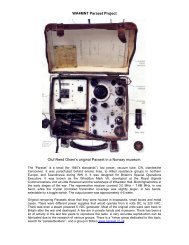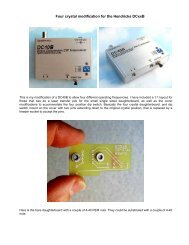Small Magnetic Loop Antenna Project - QRPBuilder.com
Small Magnetic Loop Antenna Project - QRPBuilder.com
Small Magnetic Loop Antenna Project - QRPBuilder.com
You also want an ePaper? Increase the reach of your titles
YUMPU automatically turns print PDFs into web optimized ePapers that Google loves.
The most important criterion for reception is the signal to noise ratio and not antenna gain<br />
or efficiency. In the HF band, particularly at the low-mid frequency portion, external manmade<br />
and galactic / atmospheric noise is dominant.<br />
The magnetic loop antenna has one other important practical advantage in receive mode.<br />
The aforementioned high-Q resonator imparts a very narrow band frequency selective<br />
bandpass filter ahead of the Rx front-end stages. Such an incidental preselector <strong>com</strong>prising<br />
the antenna itself imparts greatly improved receiver performance on the congested lower<br />
HF bands with high power broadcast stations and particularly when lightning strikes and<br />
atmospheric electrical discharges are present in the regional area. Unwanted overload<br />
causing and adjacent-channel QRM interference signals are rejected or heavily attenuated.<br />
As well as eliminating strong-signal overload and intermodulation effects, the filtering<br />
dramatically reduces the amount of lightning induced broadband impulse energy fed to the<br />
Rx front-end and weak signals can still be heard when reception under such adverse<br />
conditions was previously impossible.<br />
It is these collective characteristics of small loop antennas that enable them to often very<br />
significantly outperform their large dipole, Yagi or Quad beam counterparts during direct<br />
A/B <strong>com</strong>parative testing. Conversely in Tx mode the antenna’s inherent filter action<br />
selectivity causes any transmitter harmonics to be greatly attenuated and not radiated. This<br />
can help with eliminating some forms of TVI.<br />
Effects of ground on loop antenna performance:<br />
When a dipole antenna is placed horizontally above ground, its electrical “image” in the<br />
ground is of the opposite phase. As a consequence, if the height above ground of a<br />
horizontal dipole is reduced to less than ¼ wavelength, fairly high system losses develop<br />
due to a rapid decrease in radiation resistance concurrent with a rapid rise in loss resistance<br />
resulting from dissipation of power within a less than perfect ground. This represents a<br />
classic double-whammy scenario and deleterious performance for dipoles deployed at<br />
insufficient height above ground.<br />
By way of contrast, the oscillatory RF currents associated with the image of a small<br />
vertical oriented loop antenna above ground are “in-phase” with those of the loop.<br />
Therefore the effect of ground on the performance of a vertically oriented loop is relatively<br />
small. In fact, because the magnetic <strong>com</strong>ponent of an electromagnetic wave is maximum at<br />
the boundary between the ground and the space above, loop performance is usually best<br />
when the loop is located near the ground at a distance outside of the loop’s close-in<br />
induction field (just a loop diameter or two). However, if nearby conductive objects such<br />
as power lines or buildings exist in the direction of transmission / reception; it is normally<br />
preferable to choose a height above ground which will provide the loop with a clear and<br />
unobstructed view of the intended signal path.<br />
In <strong>com</strong>paring the performance of a vertical whip and a small vertical loop located atop of a<br />
building, it may be said that the loop will generally be the clear winner with respect to<br />
vertical and horizontal radiation patterns. This is because the pattern of a whip antenna<br />
driven against the top of a building is usually not predictable with any accuracy at all<br />
because vertical currents will flow all the way up and down the several conductive paths<br />
between the antenna and the earth; each path contributing to the total radiation pattern in<br />
the form of multiple lobes and nulls.<br />
6





